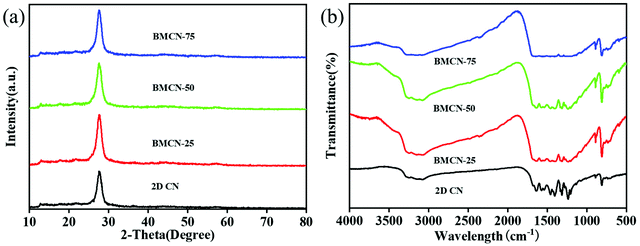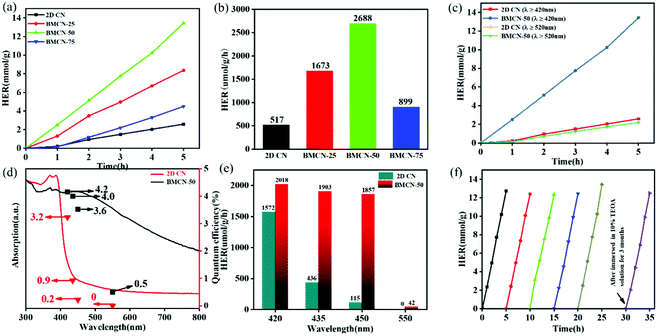Construction of brown mesoporous carbon nitride with a wide spectral response for high performance photocatalytic H2 evolution†
Jinzhou
Chen
a,
Xianglin
Zhu
*a,
Zhifeng
Jiang
 a,
Wei
Zhang
a,
Haiyan
Ji
*a,
Xingwang
Zhu
a,
Wei
Zhang
a,
Haiyan
Ji
*a,
Xingwang
Zhu
 a,
Yanhua
Song
b,
Zhao
Mo
a,
Huaming
Li
a and
Hui
Xu
a,
Yanhua
Song
b,
Zhao
Mo
a,
Huaming
Li
a and
Hui
Xu
 *a
*a
aSchool of Materials Science and Engineering, Institute for Energy Research, Jiangsu University, Zhenjiang, Jiangsu 212013, P.R. China. E-mail: zhuxl@ujs.edu.cn; hyji1013@ujs.edu.cn; xh@ujs.edu.cn
bSchool of Environmental and Chemical Engineering, Jiangsu University of Science and Technology, Zhenjiang, Jiangsu 212003, PR China
First published on 8th November 2021
Abstract
Two-dimensional graphitic carbon nitride (2D CN) shows superior photocatalytic performance due to high charge separation efficiency and the rich active sites endowed with a 2D structure. However, the 2D structure also induces the weaknesses of easier agglomeration and wider bandgap which can weaken the H2 evolution capacity. Aiming to solve these defects, we prepared a brown mesoporous carbon nitride photocatalyst through phosphorus doping (BMCN). The phosphorus doping brings an excellent visible light response, a stable mesoporous structure with rich active sites, and a more negative CB potential. The optimized BMCN-50 shows a high H2 evolution rate of 2.7 mmol g−1 h−1 which is over 5 times than that of pure 2D CN. The apparent quantum yields (AQYs) of BMCN-50 at 420 nm, 435 nm, 450 nm, and 550 nm are 4.2%, 4.0%, 3.6%, and 0.5%, respectively, which are higher than those of 2D CN (3.2%, 0.9%, 0.2%, and 0%). Besides, BMCN showed stable H2 evolution performance even after being immersed in 10% TEOA solution for three months. This work presents an easy strategy to prepare a wide spectral response carbon nitride photocatalyst with a stable mesoporous nanostructure for more efficient photocatalytic H2 evolution reaction.
1. Introduction
As global industrialization develops, non-renewable energy like fossil fuels is extensively utilized because of the advantages of being cheap and readily available. However, the massive consumption of fossil fuels leads to serious energy and environmental problems. It is a consensus that the CO2 emissions must be kept under control and the carbon-neutral goal should be achieved before the mid-21st century. The photocatalytic technique is a potential pathway to provide green energy and deal with environmental pollution. Utilizing the generated electrons and holes, photocatalysts can achieve the goal of water splitting, CO2 reduction, contaminant degradation, and N2 reduction with solar energy as input energy.1–5 Unfortunately, the low efficiency and bad stability of current catalysts stop the practical application of the photocatalytic technique.6–8Metal-free graphitic carbon nitride (g-C3N4) has been a famous material in the photocatalytic field and has attracted tremendous research attention due to its layered structure, relatively suitable band gap positions, superior electronic properties and good stability.9–14 However, it still faces similar challenges like wide band gap (∼2.8 eV) and the fast recombination of photogenerated electrons and holes.15–17 Hence, several kinds of strategies have been developed based on the principles of broadening light absorption and suppressing the recombination of photogenerated carriers.18–22 For example carbon nitride nanotubes were constructed and photons were refracted inside the nanotubes which helped the deep utilization of light energy.23,24 Through the doping strategy, the absorption edges of carbon nitride were expanded and more carriers were produced.25,26 Besides, the construction of heterojunctions,27,28 facet engineering has also proven to be an efficient approach for accelerating the transfer of charges.29,30 Recently, two-dimensional design of materials has been one hot spot in the energy conversion field.31,32 Two-dimensional (2D) g-C3N4 were prepared and widely studied in photocatalytic applications.33–35 2D CN showed much higher activity than bulk g-C3N4 due to more exposed active sites, stronger oxidation and reduction capacity, and a shorter carrier transfer distance.36 However, 2D materials usually have a wider band gap compared with their bulk phase because of their quantum size effect, which is adverse to visible light utilization. Further, serious agglomeration of ultrathin nanosheets will lead to a decrease of the specific surface area and the loss of active sites. Mesoporous materials have been proven to contain rich reaction sites and have stable structures which can overcome the defect of easy agglomeration weakness of 2D materials.37 Nonetheless, the typical synthesis of mesoporous g-C3N4 is cumbersome and requires the assistance of templates.
In this work, inspired by the advantages of the doping strategy in broadening the light capture capacity and the merits of mesoporous structures in promoting the charge separation and providing stable active sites, we present a simple and effective phosphorus doping strategy to prepare a wide spectral response BMCN photocatalyst. Benefitting from the reforming process during the P doping, the ordinary 2D CN was converted into mesoporous carbon nitride. In summation, phosphorus doping was used to achieve the purposes of both enhancing the light absorption range and providing abundant active sites. Hence BMCN showed 5 times higher H2 evolution activity than the pure 2D CN under visible light. The presented strategy offers an efficient synthetic approach towards preparing a wide spectral response, high charge separation efficiency, and rich active sites containing g-C3N4 photocatalysts.
2. Results and discussion
The crystal structures of the pristine 2D CN and P doped brown mesoporous carbon nitride (BMCN) were characterized through X-ray diffraction (XRD) as shown in Fig. 1a. The XRD of the pristine 2D CN shows two peaks located at 13.0°, and 27.5°, which is consist with the interlayer spacing features of the (100) plane, and the repeating period of the melamine-like structural unit of the (002) plane. The P doped g-C3N4 samples have similar XRD patterns compared with the original 2D CN, and this means the doping strategy does not change the crystal structure of g-C3N4. The Fourier transform infrared (FT-IR) results shown in Fig. 1b reveal the surface functional groups of as-prepared specimens. Both 2D CN and BMCN samples have similar characteristic peaks in the obtained spectra. The peak at 810 cm−1 is the characteristic breathing mode of the s-triazine ring system. The stretching vibration modes of C–N and C![[double bond, length as m-dash]](https://www.rsc.org/images/entities/char_e001.gif) N heterocycles were located in the range of 1200 cm−1 to 1800 cm−1. The N–H stretching vibrations were found in the range of 3000–3500 cm−1 shown as multiple broad peaks.5 The similar XRD and FT-IR patterns of the pristine 2D CN and BMCN prove that the P doping in this experiment does not destroy the layered structure of the graphitic carbon nitride.
N heterocycles were located in the range of 1200 cm−1 to 1800 cm−1. The N–H stretching vibrations were found in the range of 3000–3500 cm−1 shown as multiple broad peaks.5 The similar XRD and FT-IR patterns of the pristine 2D CN and BMCN prove that the P doping in this experiment does not destroy the layered structure of the graphitic carbon nitride.
It is known that the activity of g-C3N4 is seriously influenced by its morphology. Typically, g-C3N4 with a 2D structure or a thin layer structure has a better performance than those of the bulk ones because of more exposed active sites and better dispersion in the solution. Scanning Electron Microscopy (SEM) and Transmission Electron Microscopy (TEM) were used to confirm the morphology and the element distribution of the prepared samples, and the results are shown in Fig. 2. From Fig. 2a and c, we can see that 2D CN is composed of thin nanosheets, and the thickness of the nanosheets is about 1.5 nm which is confirmed by atomic force microscopy (AFM) analysis as shown in Fig. S1.† The bulk carbon nitride has no exposed sheets on its surface (Fig. S2†). The SEM and TEM results shown in Fig. 2b, d, and e demonstrate that the brown mesoporous carbon nitride loses its nanosheet structure, and attains bulk-like morphology. The high-angle annular dark-field (HAADF) STEM image (Fig. 2f) and elemental mapping results (Fig. 2g–i) show that the doped P is uniformly distributed in BMCN.
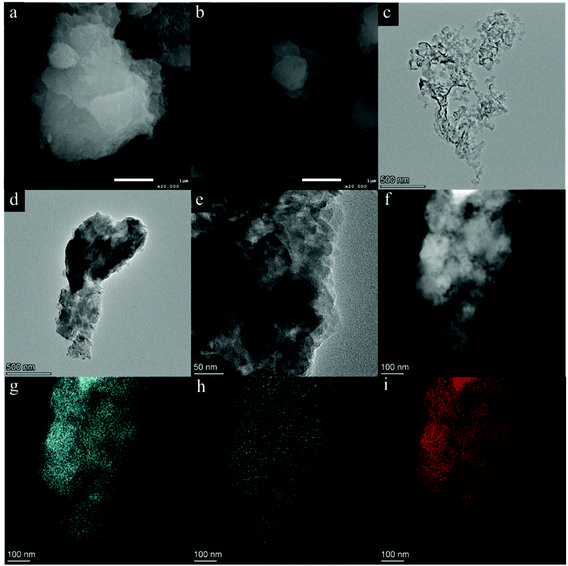 | ||
| Fig. 2 (a) SEM image of 2D CN, (b) SEM image of BMCN-50 (c) TEM image of 2D CN, (d and e) TEM image of 2D BMCN-50, and (f–i) HAADF STEM image and elemental mapping results of N, P, and C in BMCN-50. | ||
From the SEM and TEM results, it can be seen that the microstructure and morphology of the carbon nitride changed from 2D sheets to bulk, which may reduce the number of surface-active sites. Hence, it is necessary to investigate specific surface area properties. Fig. 3a presents the N2 adsorption–desorption isotherms of the synthesized specimens. The surface BET area of 2D CN and BMCN-50 is 104.466 m2 g−1 and 109.822 m2 g−1, respectively. The slight difference of the BET surface area indicates that the change in the amount of exposed active sites is not the main influencing factor for the H2 evolution performance. However, the adsorption–desorption types were changed from Type III (macropores) to Type IVa (mesopores, cylindrical pore shape).38 The formed mesoporous properties of BMCN-50 can explain the slight reinforcement of the BET surface area despite the dramatic morphology change. The pore size distribution curves shown in Fig. 3b are consistent with the N2 isotherm adsorption curves, and one obvious peak is observed in the range of 4–7 nm in BMCN-50 which is different from 2D CN. The N2 adsorption–desorption isotherm curves and the pore size distribution curves prove the generation of mesoporous carbon nitride whose structure is more stable than the ultrathin layer carbon nitride.
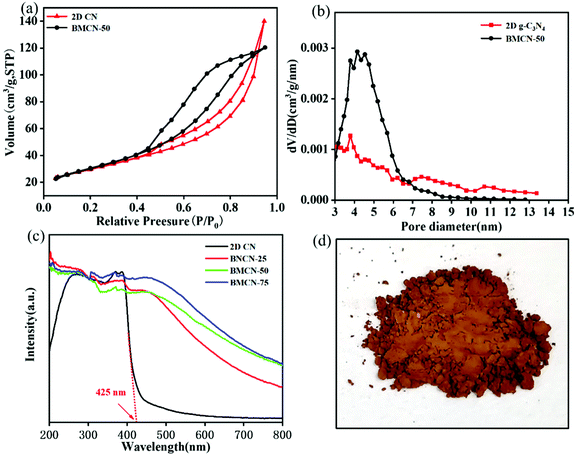 | ||
| Fig. 3 (a) N2 adsorption–desorption isotherm curves, (b) pore size distribution curves, (c) UV-vis absorption spectra results, and (d) photograph of the BMCN-50 sample. | ||
The optical features of the prepared catalysts were investigated using the UV-vis absorption spectral technique, and the results are shown in Fig. 3c. From the patterns of the absorption spectra, it can be seen that 2D CN shows a typical absorption edge at about 425 nm (band gap: ∼2.8 eV) and a weak response for light of λ > 450 nm. This is because of the quantum size effect which improves redox ability but broadens the band gap of semiconductor photocatalysts. With the doping of P, optical features are changed dramatically, especially in the visible light region. BMCN samples exhibit strong light absorption capacities in the entire visible light range. The UV-vis absorption spectra results indicate that the doping of P into carbon nitride is helpful for the capture of visible light which is important for the enhancement of activity. Light absorption of the samples can also be judged from their color difference, which is a convenient method. The color of the sample changes from light yellow to brown after P doping as shown in Fig. 3d.
The chemical composition details of the photocatalysts were determined using X-ray photoelectron spectroscopy (XPS). As seen in Fig. 4a, peaks around 288, 398 and 532 eV in 2D CN and BMCN-50 are attributed to the binding energies of C 1s, N 1s, and O 1s, respecitively. The O signal is caused by the surface adsorbed H2O or CO2. A more detailed representation of the binding energy of C, N, and P is exhibited in the corresponding high resolution XPS spectral patterns (Fig. 4b–d). The peaks located at 284.8, 286.14, and 288.28 eV in the C 1s spectrum of Fig. 4b are assigned to the signals of carbon impurities, the sp2 C atoms in the aromatic ring linked with the –NH2 group, and the sp2 carbon (bonded as N![[double bond, length as m-dash]](https://www.rsc.org/images/entities/char_e001.gif) C–N) in the aromatic ring, respectively. The N 1s spectrum is also composed of three peaks. The peak centered at 398.1 eV is ascribed to the sp2-hybridized nitrogen (N–C
C–N) in the aromatic ring, respectively. The N 1s spectrum is also composed of three peaks. The peak centered at 398.1 eV is ascribed to the sp2-hybridized nitrogen (N–C![[double bond, length as m-dash]](https://www.rsc.org/images/entities/char_e001.gif) N). The peak centered at 400.09 eV is attributed to the tertiary nitrogen (N–(C)3) and the peak centered at 401.31 eV is attributed to terminal amino groups (C–NH).39 The XPS results of BMCN display two differences in comparison with 2D CN. The C 1s peak centered at 286.25 eV displays a positive shift compared with 2D CN which indicates the electronegativity change of the neighboring N atom. A peak corresponding to P–N occurs at around 133.43 eV.40 Combining the C 1s and N 1s spectra results, we can propose a hypothesis that the doping of P takes place at sp2-hybridized carbon (N–C
N). The peak centered at 400.09 eV is attributed to the tertiary nitrogen (N–(C)3) and the peak centered at 401.31 eV is attributed to terminal amino groups (C–NH).39 The XPS results of BMCN display two differences in comparison with 2D CN. The C 1s peak centered at 286.25 eV displays a positive shift compared with 2D CN which indicates the electronegativity change of the neighboring N atom. A peak corresponding to P–N occurs at around 133.43 eV.40 Combining the C 1s and N 1s spectra results, we can propose a hypothesis that the doping of P takes place at sp2-hybridized carbon (N–C![[double bond, length as m-dash]](https://www.rsc.org/images/entities/char_e001.gif) N) sites.
N) sites.
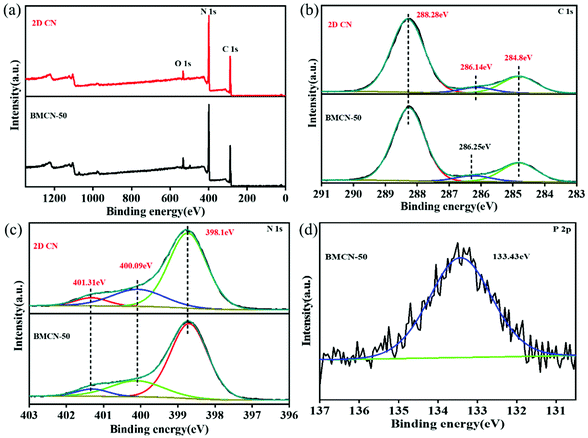 | ||
| Fig. 4 (a) Total XPS survey spectra, (b) high-resolution XPS spectra of C 1s, (c) N 1s and (d) P 2p. | ||
The photocatalytic activities of the prepared catalysts were evaluated from H2 evolution under visible light (λ ≥ 420 nm) and the results are shown in Fig. 5. Fig. 5a shows the photocatalytic H2 evolution amount of the different samples over time. With the increase in the amount of NaH2PO2 used, the H2 evolution activities of the catalysts were enhanced and BMCN-50 shows the best performance of 13.44 mmol g−1 in five hours which is over 5.2 times than that of the pristine 2D CN (2.58 mmol g−1). The H2 evolution activities get worse with the over-introduction of phosphorus. This could be attributed to the negative effects of excessive defects or damaged structures. Fig. 5b shows the average H2 evolution rates of the prepared photocatalysts and the average H2 evolution rate is 2688 μmol g−1 h−1 for the BMCN-50 sample. Fig. 5c presents the photocatalytic H2 evolution activities of BMCN-50 using 420 nm and 520 nm cut-off filters. BMCN-50 shows comparable activity under λ ≥ 520 nm irradiation in comparison with the activity of 2D CN under λ ≥ 420 nm irradiation which proves the wide spectral photocatalytic H2 capacity of BMCN. The apparent quantum yield (AQY) is an important parameter to evaluate the energy conversion efficiency under the irradiation of light of a certain wavelength. The AQYs of BMCN-50 at 420 nm, 435 nm, 450 nm, and 550 nm are 4.2%, 4.0%, 3.6%, and 0.5%, respectively as shown in Fig. 5d, which is higher than those of 2D CN (3.2%, 0.9%, 0.2%, and 0%, respectively). The higher AQY results of BMCN-50 prove the better separation efficiency of the carriers compared with the pristine 2D CN. Additionally, the BMCN-50 sample exhibits photocatalytic H2 evolution activity even under the irradiation of 550 nm light (Fig. 5e), which indicates that the broadening of the light response caused by P doping is effective and it is not just a change of the color. The stability of the photocatalyst is also an important standard in the photocatalytic application. The cycling experiment is a classic method to validate the stability of specimens. In Fig. 5f, the H2 evolution performance of BMCN-50 has no obvious attenuation after the 5 cycles’ test under visible light irradiation. Besides, the photocatalytic activity was tested again after the catalyst was stored in a 10% TEOA solution for three months and the result showed that the activity still remained stable. The stability of BMCN was also confirmed by XRD as shown in Fig. S3.† The H2 evolution experiments prove that the BMCN-50 sample not only exhibits excellent performance but also has high stability.
To further investigate the internal carrier separation mechanism, photoelectrochemical measurements were performed to characterize the effective separation and migration resistance of photo-excited carriers.41Fig. 6a exhibits the photocurrent of as-prepared specimens. All BMCN catalysts showed higher photocurrents than 2D CN. The order of the photocurrent intensity is as follows: BMCN-50 > BMCN-25 > BMCN-75 > 2D CN, which is consistent with the sequence of the H2 evolution activities. BMCN-50 has the biggest photocurrent intensity (Fig. 6a). The notably enhanced photocurrent intensities of BMCN samples over 2D CN illustrate more separated carriers in the reaction which may be caused by the improved light response or the more efficient charge separation efficiency. The recombination of the photo-induced charge carriers is measured using the PL emission spectra. The peak intensity of BMCN-50 is much lower than that of the pristine 2D CN which indicates that BMCN-50 has a lower recombination of charge carriers (Fig. 6b). The characterization is also consistent with TRPL (Fig. S6†). The average lifetime of BMCN-50 decreases to 2.73 ns (2D CN: 9.84 ns), demonstrating that the mesoporous structure may provide a new non-radiative decay channel for the charge transfer, thus reducing the recombination of electrons and holes. The electrochemical impedance spectroscopy (EIS) measurement depicts the migration behavior of photo-excited carriers. The internal resistance and the total resistance are two coefficients of concern in the EIS measurement. The diameters of the semicircular arc denote the resistance to charge migration. Smaller diameters of the semicircular arc represent a lower resistance in transportation. It is obvious that all BMCN samples show a close internal resistance compared with 2D CN, but have a bigger total resistance than 2D CN (Fig. 6c). To summarize the results of the photocurrent test, from the PL emission spectra, the EIS, and H2 evolution reactions, especially the AQY test, we can conclude that the higher charge separation efficiency of the BMCN catalyst is mainly benefited from the more efficient H2 generation step rather than the faster migration of carriers caused by the smaller internal resistance in the catalyst. The higher total resistance of BMCN is due to the formation of a mesoporous structure which is not conducive to electrolyte diffusion compared with the thin layer structure of 2D CN. The flat band potentials of 2D CN and BMCN are −0.84 V and −0.65 V, respectively, (Fig. 6d) and this means the photoelectrons generated by BMCN have a higher energy which is helpful for the H2 evolution reaction. Furthermore, the valence band (VB) positions of 2D CN and BMCN were identified in the valence band spectrum (Fig. S5†). The results prove that the valence band positions of 2D CN and BMCN have no significant difference. Mott–Schottky and valence band spectrum results show that the doping of P forms a new intermediate level between the CB and VB. The intermediate level enhanced the light absorption capacity significantly.
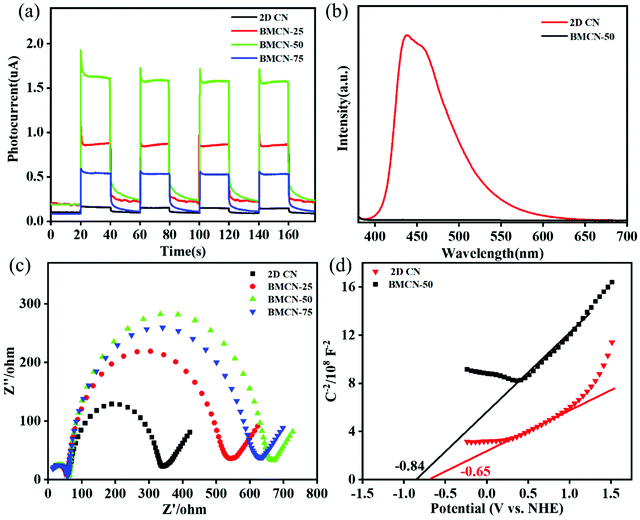 | ||
| Fig. 6 (a) Photocurrent tests of 2D CN and BMCN samples, (b) PL spectra of 2D CN and BMCN-50, (c) EIS plots of 2D CN and BMCN samples, and (d) Mott Schottky plots of 2D CN and BMCN-50. | ||
3. Conclusion
In summary, we synthesized an efficient brown mesoporous carbon nitride photocatalyst (BMCN) through an in situ phosphating approach derived from 2D CN. The prepared BMCN photocatalysts have three new features: a wide spectral response, a mesoporous structure, and a more negative CB potential. These new features endow BMCN photocatalysts with better visible light absorption capacity, a more stable surface structure with abundant active sites, more efficient charge separation, and stronger reduction ability in the photocatalytic H2 evolution. As a result, the prepared BMCN photocatalysts exhibit excellent H2 evolution activity and stability under visible light irradiation. The optimized BMCN-50 shows a high H2 evolution rate of 2.7 mmol g−1 h−1 which is over 5 times greater than that of the pure 2D CN. This work will provide a reference for the design of wide spectral response carbon nitride photocatalysts with a special nanostructure for a more efficient solar energy conversion application.Conflicts of interest
There are no conflicts to declare.Acknowledgements
This study was financially supported by the National Natural Science Foundation of China (22005123, 21776118 and 22108110), the Jiangsu Postdoctoral Science Foundation (2021K382C and 2021K079A), the Jiangsu University Foundation (20JDG16), Jiangsu Funds for Distinguished Young Scientists (BK20190045), the China Postdoctoral Science Foundation (2021M691305), the Jiangsu Agricultural Science and Technology Independent Innovation Fund (CX(21)3067), and the Postgraduate High-tech Research Key laboratory of Zhenjiang (SS2018002).References
- X. Xue, R. Chen, C. Yan, P. Zhao, Y. Hu, W. Zhang, S. Yang and Z. Jin, Review on photocatalytic and electrocatalytic artificial nitrogen fixation for ammonia synthesis at mild conditions: Advances, challenges and perspectives, Nano Res., 2019, 12(6), 1229–1249 CrossRef CAS.
- P. Huang, J. Huang, S. A. Pantovich, A. D. Carl, T. G. Fenton, C. A. Caputo, R. L. Grimm, A. I. Frenkel and G. Li, Selective CO2 Reduction Catalyzed by Single Cobalt Sites on Carbon Nitride under Visible-Light Irradiation, J. Am. Chem. Soc., 2018, 140(47), 16042–16047 CrossRef CAS PubMed.
- X. Song, G. Wei, J. Sun, C. Peng, J. Yin, X. Zhang, Y. Jiang and H. Fei, Overall photocatalytic water splitting by an organolead iodide crystalline material, Nat. Catal., 2020, 3(12), 1027–1033 CrossRef CAS.
- X. Zhu, J. Yang, X. Zhu, J. Yuan, M. Zhou, X. She, Q. Yu, Y. Song, Y. She, Y. Hua, H. Li and H. Xu, Exploring deep effects of atomic vacancies on activating CO2 photoreduction via rationally designing indium oxide photocatalysts, Chem. Eng. J., 2021, 422, 129888 CrossRef CAS.
- X. Zhu, Z. Wang, K. Zhong, Q. Li, P. Ding, Z. Feng, J. Yang, Y. Du, Y. Song, Y. Hua, J. Yuan, Y. She, H. Li and H. Xu, Mo-O-Bi bonds as interfacial electron transport bridges to fuel CO2 photoreduction via in-situ reconstruction of black Bi2MoO6/BiO2-x heterojunction, Chem. Eng. J., 2022, 429, 132204 CrossRef CAS.
- G. Zhang, M. Liu, T. Heil, S. Zafeiratos, A. Savateev, M. Antonietti and X. Wang, Electron Deficient Monomers that Optimize Nucleation and Enhance the Photocatalytic Redox Activity of Carbon Nitrides, Angew. Chem., Int. Ed., 2019, 58(42), 14950–14954 CrossRef CAS PubMed.
- X. Zhu, S. Huang, Q. Yu, Y. She, J. Yang, G. Zhou, Q. Li, X. She, J. Deng, H. Li and H. Xu, In-situ hydroxyl modification of monolayer black phosphorus for stable photocatalytic carbon dioxide conversion, Appl. Catal., B, 2020, 269, 118760 CrossRef CAS.
- X. Zhu, Y. Cao, Y. Song, J. Yang, X. She, Z. Mo, Y. She, Q. Yu, X. Zhu, J. Yuan, H. Li and H. Xu, Unique Dual-sites Boosting Overall CO2 Photoconversion by Hierarchical Electron Harvesters, Small, 2021, 17, 2103796 CrossRef CAS.
- X. Zhu, G. Zhou, J. Yi, P. Ding, J. Yang, K. Zhong, Y. Song, Y. Hua, X. Zhu, J. Yuan, Y. She, H. Li and H. Xu, Accelerated Photoreduction of CO2 to CO over a Stable Heterostructure with a Seamless Interface, ACS Appl. Mater. Interfaces, 2021, 13, 39523–39532 CrossRef CAS.
- Y. Lin, W. Su, X. Wang, X. Fu and X. Wang, LaOCl-Coupled Polymeric Carbon Nitride for Overall Water Splitting through a One-Photon Excitation Pathway, Angew. Chem., Int. Ed., 2020, 59(47), 20919–20923 CrossRef CAS.
- X. Zhu, J. Yang, X. She, Y. Song, J. Qian, Y. Wang, H. Xu, H. Li and Q. Yan, Rapid synthesis of ultrathin 2D materials through liquid-nitrogen and microwave treatments, J. Mater. Chem. A, 2019, 7, 5029–5213 Search PubMed.
- P. Xia, M. Antonietti, B. Zhu, T. Heil, J. Yu and S. Cao, Designing Defective Crystalline Carbon Nitride to Enable Selective CO2 Photoreduction in the Gas Phase, Adv. Funct. Mater., 2019, 29(15), 1900093 CrossRef.
- P. Kumar, E. Vahidzadeh, W. K. Thakur, P. Kar, K. M. Alam, A. Goswami, N. Mandi, K. Cui, G. M. Bernard, V. K. Michaelis and K. Shankar, C3N5: A Low Bandgap Semiconductor Containing an Azo-Linked Carbon Nitride Framework for Photocatalytic, Photovoltaic and Adsorbent Applications, J. Am. Chem. Soc., 2019, 141(13), 5415–5436 CrossRef CAS PubMed.
- C. Hu, F. Chen, Y. Wang, N. Tian, T. Ma, Y. Zhang and H. Huang, Exceptional Cocatalyst-Free Photo-Enhanced Piezocatalytic Hydrogen Evolution of Carbon Nitride Nanosheets from Strong In-Plane Polarization, Adv. Mater., 2021, 33(24), 2101751 CrossRef CAS PubMed.
- Y. Zhao, P. Zhang, Z. Yang, L. Li, J. Gao, S. Chen, T. Xie, C. Diao, S. Xi, B. Xiao, C. Hu and W. Choi, Mechanistic analysis of multiple processes controlling solar-driven H2O2 synthesis using engineered polymeric carbon nitride, Nat. Commun., 2021, 12(1), 3701 CrossRef CAS PubMed.
- Y. Chen, X. Liu, L. Hou, X. Guo, R. Fu and J. Sun, Construction of covalent bonding oxygen-doped carbon nitride/graphitic carbon nitride Z-scheme heterojunction for enhanced visible-light-driven H2 evolution, Chem. Eng. J., 2020, 383, 123132 CrossRef CAS.
- P. Chen, B. Lei, X. A. Dong, H. Wang, J. Sheng, W. Cui, J. Li, Y. Sun, Z. Wang and F. Dong, Rare-Earth Single-Atom La-N Charge-Transfer Bridge on Carbon Nitride for Highly Efficient and Selective Photocatalytic CO2 Reduction, ACS Nano, 2020, 14(11), 15841–15852 CrossRef PubMed.
- Z. Chen, Y. Bu, L. Wang, X. Wang and J.-P. Ao, Single-sites Rh-phosphide modified carbon nitride photocatalyst for boosting hydrogen evolution under visible light, Appl. Catal., B, 2020, 274, 119117 CrossRef CAS.
- G. Wang, T. Zhang, W. Yu, R. Si, Y. Liu and Z. Zhao, Modulating Location of Single Copper Atoms in Polymeric Carbon Nitride for Enhanced Photoredox Catalysis, ACS Catal., 2020, 10(10), 5715–5722 CrossRef CAS.
- S. Kang, M. He, M. Chen, Y. Liu, Y. Wang, Y. Wang, M. Dong, X. Chang and L. Cui, Surface Amino Group Regulation and Structural Engineering of Graphitic Carbon Nitride with Enhanced Photocatalytic Activity by Ultrafast Ammonia Plasma Immersion Modification, ACS Appl. Mater. Interfaces, 2019, 11(16), 14952–14959 CrossRef CAS.
- S. Kang, M. He, M. Chen, J. Wang, L. Zheng, X. Chang, H. Duan, D. Sun, M. Dong and L. Cui, Ultrafast plasma immersion strategy for rational modulation of oxygen-containing and amino groups in graphitic carbon nitride, Carbon, 2020, 159, 51–64 CrossRef CAS.
- Z. Zhang, L. Cui, Y. Zhang, L. H. Klausen, M. Chen, D. Sun, S. Xu, S. Kang and J. Shi, Regulation of carboxyl groups and structural defects of graphitic carbon nitride via environmental-friendly glucose oxidase ring-opening modulation, Appl. Catal., B, 2021, 297, 120441 CrossRef CAS.
- Y. Wang, X. Q. Liu, J. Liu, B. Han, X. Q. Hu, F. Yang, Z. W. Xu, Y. C. Li, S. R. Jia, Z. Li and Y. L. Zhao, Carbon Quantum Dot Implanted Graphite Carbon Nitride Nanotubes: Excellent Charge Separation and Enhanced Photocatalytic Hydrogen Evolution, Angew. Chem., Int. Ed., 2018, 57(20), 5765–5771 CrossRef CAS PubMed.
- X. Li, S. A. Bartlett, J. M. Hook, I. Sergeyev, E. B. Clatworthy, A. F. Masters and T. Maschmeyer, Salt-enhanced photocatalytic hydrogen production from water with carbon nitride nanorod photocatalysts: cation and pH dependence, J. Mater. Chem. A, 2019, 7(32), 18987–18995 RSC.
- D. Zhao, Y. Wang, C.-L. Dong, Y.-C. Huang, J. Chen, F. Xue, S. Shen and L. Guo, Boron-doped nitrogen-deficient carbon nitride-based Z-scheme heterostructures for photocatalytic overall water splitting, Nat. Energy, 2021, 6(4), 388–397 CrossRef CAS.
- S. Wu, H. Yu, S. Chen and X. Quan, Enhanced Photocatalytic H2O2 Production over Carbon Nitride by Doping and Defect Engineering, ACS Catal., 2020, 10(24), 14380–14389 CrossRef CAS.
- W. Shi, M. Li, X. Huang, H. Ren, C. Yan and F. Guo, Facile synthesis of 2D/2D Co3(PO4)2/g-C3N4 heterojunction for highly photocatalytic overall water splitting under visible light, Chem. Eng. J., 2020, 382, 122960 CrossRef CAS.
- W. Che, W. Cheng, T. Yao, F. Tang, W. Liu, H. Su, Y. Huang, Q. Liu, J. Liu, F. Hu, Z. Pan, Z. Sun and S. Wei, Fast Photoelectron Transfer in (C-ring)-C3N4 Plane Heterostructural Nanosheets for Overall Water Splitting, J. Am. Chem. Soc., 2017, 139(8), 3021–3026 CrossRef CAS.
- L. Lin, Z. Lin, J. Zhang, X. Cai, W. Lin, Z. Yu and X. Wang, Molecular-level insights on the reactive facet of carbon nitride single crystals photocatalysing overall water splitting, Nat. Catal., 2020, 3(8), 649–655 CrossRef CAS.
- H. Ou, L. Lin, Y. Zheng, P. Yang, Y. Fang and X. Wang, Tri-s-triazine-Based Crystalline Carbon Nitride Nanosheets for an Improved Hydrogen Evolution, Adv. Mater., 2017, 29(22), 1700008 CrossRef PubMed.
- L. Tang, X. Meng, D. Deng and X. Bao, Confinement Catalysis with 2D Materials for Energy Conversion, Adv. Mater., 2019, 31(50), 1901996 CrossRef CAS PubMed.
- X. Zhu, G. Zhou, Z. Wang, K. Zhong, P. Ding, Y. Song, J. Yuan, Y. She, H. Li and H. Xu, Nanostructure and functional group engineering of black phosphorus via plasma treatment for CO2 photoreduction, J. CO2 Util., 2021, 54, 101745 CrossRef CAS.
- Y. Song, J. Gu, K. Xia, J. Yi, H. Chen, X. She, Z. Chen, C. Ding, H. Li and H. Xu, Construction of 2D SnS2/g-C3N4 Z-scheme composite with superior visible-light photocatalytic performance, Appl. Surf. Sci., 2019, 467–468, 56–64 CrossRef CAS.
- D. Zhao, Y. Wang, C.-L. Dong, Y.-C. Huang, J. Chen, F. Xue, S. Shen and L. Guo, Boron-doped nitrogen-deficient carbon nitride-based Z-scheme heterostructures for photocatalytic overall water splitting, Nat. Energy, 2021, 6(4), 388–397 CrossRef CAS.
- M. Chen, Y. Zhang, L. Cui, Z. Cao, Y. Wang, W. Zhang, Y. Zheng, D. Sun, L. Zheng, S. Kang and D. Zhang, Protonated 2D carbon nitride sensitized with Ce6 as a smart metal-free nanoplatform for boosted acute multimodal photo-sono tumor inactivation and long-term cancer immunotherapy, Chem. Eng. J., 2021, 422, 130089 CrossRef CAS.
- J. Yi, T. Fei, L. Li, Q. Yu, S. Zhang, Y. Song, J. Lian, X. Zhu, J. Deng, H. Xu and H. Li, Large-scale production of ultrathin carbon nitride-based photocatalysts for high-yield hydrogen evolution, Appl. Catal., B, 2021, 281, 119475 CrossRef CAS.
- N. Tian, Y. Zhang, X. Li, K. Xiao, X. Du, F. Dong, G. I. N. Waterhouse, T. Zhang and H. Huang, Precursor-reforming protocol to 3D mesoporous g-C3N4 established by ultrathin self-doped nanosheets for superior hydrogen evolution, Nano Energy, 2017, 38, 72–81 CrossRef CAS.
- S. Sun, F. Liang, L. Tang, J. Wu and C. Ma, Microstructural investigation of gas shale in Longmaxi Formation, Lower Silurian, NE Sichuan Basin, China, Energy Explor. Exploit., 2017, 35(4), 406–429 CrossRef CAS.
- J. R. Zhang, Y. Ma, S. Y. Wang, J. Ding, B. Gao, E. Kan and W. Hua, Accurate K-edge X-ray photoelectron and absorption spectra of g-C3N4 nanosheets by first-principles simulations and reinterpretations, Phys. Chem. Chem. Phys., 2019, 21(41), 22819–22830 RSC.
- H. Bi, X. He, H. Zhang, H. Li, N. Xiao and J. Qiu, N, P co-doped hierarchical porous carbon from rapeseed cake with enhanced supercapacitance, Renewable Energy, 2021, 170, 188–196 CrossRef CAS.
- Q. Wang and K. Domen, Particulate Photocatalysts for Light-Driven Water Splitting: Mechanisms, Challenges, and Design Strategies, Chem. Rev., 2020, 120(2), 919–985 CrossRef CAS PubMed.
Footnote |
| † Electronic supplementary information (ESI) available. See DOI: 10.1039/d1qi01137e |
| This journal is © the Partner Organisations 2022 |

